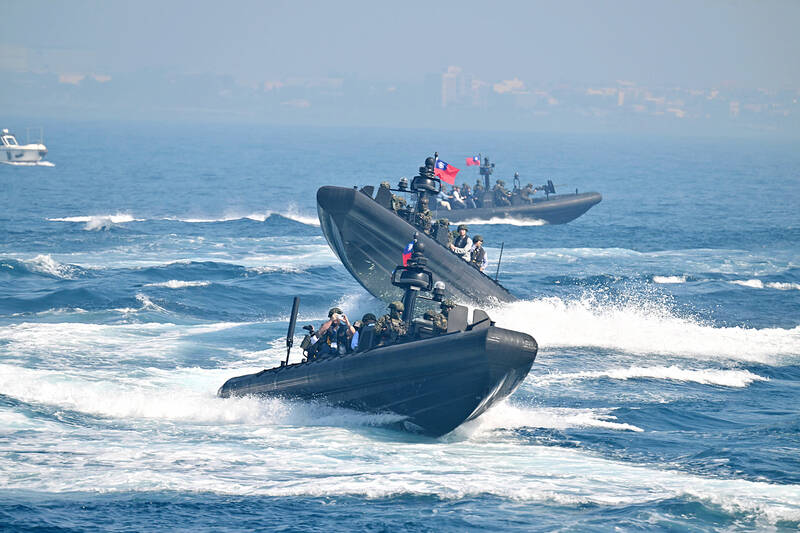The Ministry of National Defense has ordered the Marine Corps to increase troops stationed in bases in the greater Taipei area to respond to potential strikes from China against the capital, a military source said.
The Marine Amphibious Reconnaissance and Patrol Unit is to join the troops in defending the Tamsui River (淡水河) and Port of Taipei (台北港), the source said on condition of anonymity.
In 2017, the 66th Marine Brigade was stationed at the Political Warfare Academy in Taipei’s Beitou District (北投), the first combat unit to be stationed in Taipei other than the military police, the source said.

Photo: Tu Chien-jung, Taipei Times
Assessments of Taipei’s security made the military decide to send further reinforcements, leading to this month’s deployment of marines on the Tamsui River, the source said.
The reconnaissance unit is to work with the Guandu Area Command and the Coast Guard Administration to jointly carry out river defense missions, the source added.
The 66th Marine Brigade must also defend key infrastructure such as the Port of Taipei, the source said, adding that specific arrangements are in place for task forces within the unit.
Although the security of Taipei has been the responsibility of the military police, the security situation required strengthening the area’s defenses and might one day lead to a combined military police-marine corps defense arrangement for Taipei, they said.
The structure and organization of Taiwan’s naval forces would be adjusted next year, military sources have said previously.
These changes include integrating new anti-ship missiles, fast attack boats and reconnaissance units into the newly established Coastal Defense Operations Command, they said.
Furthermore, the Marine Corps’ structure would be adjusted away from heavy equipment in favor of focusing on rapid deployment, with plans to become clearer later this year, they added.

ALIGNED THINKING: Taiwan and Japan have a mutual interest in trade, culture and engineering, and can work together for stability, Cho Jung-tai said Taiwan and Japan are two like-minded countries willing to work together to form a “safety barrier” in the Indo-Pacific region, Premier Cho Jung-tai (卓榮泰) yesterday said at the opening ceremony of the 35th Taiwan-Japan Modern Engineering and Technology Symposium in Taipei. Taiwan and Japan are close geographically and closer emotionally, he added. Citing the overflowing of a barrier lake in the Mataian River (馬太鞍溪) in September, Cho said the submersible water level sensors given by Japan during the disaster helped Taiwan monitor the lake’s water levels more accurately. Japan also provided a lot of vaccines early in the outbreak of the COVID-19 pandemic,

Kaohsiung Mayor Chen Chi-mai (陳其邁) on Monday announced light shows and themed traffic lights to welcome fans of South Korean pop group Twice to the port city. The group is to play Kaohsiung on Saturday as part of its “This Is For” world tour. It would be the group’s first performance in Taiwan since its debut 10 years ago. The all-female group consists of five South Koreans, three Japanese and Tainan’s Chou Tzu-yu (周子瑜), the first Taiwan-born and raised member of a South Korean girl group. To promote the group’s arrival, the city has been holding a series of events, including a pop-up

TEMPORAL/SPIRITUAL: Beijing’s claim that the next Buddhist leader must come from China is a heavy-handed political maneuver that will fall flat-faced, experts said China’s requirement that the Dalai Lama’s reincarnation to be born in China and approved by Beijing has drawn criticism, with experts at a forum in Taipei yesterday saying that if Beijing were to put forth its own Dalai Lama, the person would not be recognized by the Tibetan Buddhist community. The experts made a remarks at the two-day forum hosted by the Tibet Religious Foundation of His Holiness the Dalai Lama titled: “The Snow Land Forum: Finding Common Ground on Tibet.” China says it has the right to determine the Dalai Lama’s reincarnation, as it claims sovereignty over Tibet since ancient times,

Temperatures in some parts of Taiwan are expected to fall sharply to lows of 15°C later this week as seasonal northeasterly winds strengthen, the Central Weather Administration (CWA) said today. It is to be the strongest cold wave to affect northern Taiwan this autumn, while Chiayi County in the southwest and some parts of central Taiwan are likely to also see lower temperatures due to radiational cooling, which occurs under conditions of clear skies, light winds and dry weather, the CWA said. Across Taiwan, temperatures are to fall gradually this week, dropping to 15°C to 16°C in the early hours of Wednesday